sanxingdui
︎Sculpture, Spirituality, Article
︎ Ventral Is Golden
sanxingdui
︎Sculpture, Spirituality, Article
︎ Ventral Is Golden
︎ Ventral Is Golden
“The ancient Masters were profound and subtle. Their wisdom was unfathomable. There is no way to describe it; all we can describe is their appearance. They were careful as someone crossing an icy stream. Alert as a warrior in enemy territory. Courteous as a guest. Fluid as melting ice. Shapable as a block of wood. Receptive as a valley. Clear as a glass of water.” - Lao Tzu.

Since recorded history to the present day, it has been the foundation and source of a country’s power, both in spiritual and military terms, to centralise its mythic tradition so that a national identity can be venerated via an origin story, and maintained to shape the consciousness of a particular region and its people.
There have been many theories suggesting how the development of consciousness through to the rise of modern civilisations has taken place, from Julian Jayne’s Bicameral Mind - a kind of non-conscious, mythic sensibility that is experienced as the ‘voice of god’ in the mind of pre-literate societies, to Karl Jaspers’ Axial Age - a suggested turning point in the history of philosophy, from around 500BC, that saw the emergence of cultural figures rise almost simultaneously across the Eurasian continent, with the likes of Lao-Tzu writing the Tao te Ching in China, the Buddha formulating the Upanishads across India and the subsequent rise of Buddhism and Hindusim through the subcontinent, to Zarathustra and the Avestas in Iran and the Persian Empire, to ancient Greece, where the likes of Homer, Plato, Parmenides and Heraclitus were shaping cultural thought.
Across the Eurasian continent, the break down of tribal communities and their reconstruction into new forms of institutional patterns were taking place. Overall these phenomena were experienced in a multitude of different forms but culminated in what Jaspers thought of as ‘a basis for a theory of universal history’ that lead to a transcendental breakthrough toward a ‘consciousness-of-being’ as a whole, and to self-consciousness in general (source) - a moment in historical time when old certainties had lost their validity and new ones were still in the process of being made.
The late anarchist anthropologist, David Graeber once suggested that the rise of these Axial Age thinkers also corresponded with the introduction of coinage, particularly in areas where these cultural figures were received.
In his essay on ‘Culture as Creative Refusal’, Graeber goes onto say that we tend to assume that so called ‘primitive’ cultures (prior to the institutions of the Axial Age) were somehow primordial or, at best, the product of some deep but ultimately arbitrary cultural matrix, but certainly not a self-conscious political project on the part of actors just as mature and sophisticated as modern-day people.
Rather, Graeber is suggesitng that these early cultures were consciously self-defining as a form of refusal to integrate into larger urban centres.
Furthermore, Graeber elucidates a phenomena, scattered across a band of territory that runs from roughly the Danube to the Ganges, where treasure troves full of large amounts of extremely valuable metalware that appear to have been self-consciously abandoned or even systematically destroyed always seem to appear where cultures mysteriously disappear. The remarkable thing is that such troves never occur within the great urban civilisations themselves, but always in the surrounding marginal zones that were closely connected to the commercial and bureaucratic centres by trade but were in no sense incorporated, and the recently discovered sacrificial pits of the ancient Sanxingdui culture in modern day China are no exception to this trend.
There have been many theories suggesting how the development of consciousness through to the rise of modern civilisations has taken place, from Julian Jayne’s Bicameral Mind - a kind of non-conscious, mythic sensibility that is experienced as the ‘voice of god’ in the mind of pre-literate societies, to Karl Jaspers’ Axial Age - a suggested turning point in the history of philosophy, from around 500BC, that saw the emergence of cultural figures rise almost simultaneously across the Eurasian continent, with the likes of Lao-Tzu writing the Tao te Ching in China, the Buddha formulating the Upanishads across India and the subsequent rise of Buddhism and Hindusim through the subcontinent, to Zarathustra and the Avestas in Iran and the Persian Empire, to ancient Greece, where the likes of Homer, Plato, Parmenides and Heraclitus were shaping cultural thought.
Across the Eurasian continent, the break down of tribal communities and their reconstruction into new forms of institutional patterns were taking place. Overall these phenomena were experienced in a multitude of different forms but culminated in what Jaspers thought of as ‘a basis for a theory of universal history’ that lead to a transcendental breakthrough toward a ‘consciousness-of-being’ as a whole, and to self-consciousness in general (source) - a moment in historical time when old certainties had lost their validity and new ones were still in the process of being made.
The late anarchist anthropologist, David Graeber once suggested that the rise of these Axial Age thinkers also corresponded with the introduction of coinage, particularly in areas where these cultural figures were received.
In his essay on ‘Culture as Creative Refusal’, Graeber goes onto say that we tend to assume that so called ‘primitive’ cultures (prior to the institutions of the Axial Age) were somehow primordial or, at best, the product of some deep but ultimately arbitrary cultural matrix, but certainly not a self-conscious political project on the part of actors just as mature and sophisticated as modern-day people.
Rather, Graeber is suggesitng that these early cultures were consciously self-defining as a form of refusal to integrate into larger urban centres.
Furthermore, Graeber elucidates a phenomena, scattered across a band of territory that runs from roughly the Danube to the Ganges, where treasure troves full of large amounts of extremely valuable metalware that appear to have been self-consciously abandoned or even systematically destroyed always seem to appear where cultures mysteriously disappear. The remarkable thing is that such troves never occur within the great urban civilisations themselves, but always in the surrounding marginal zones that were closely connected to the commercial and bureaucratic centres by trade but were in no sense incorporated, and the recently discovered sacrificial pits of the ancient Sanxingdui culture in modern day China are no exception to this trend.
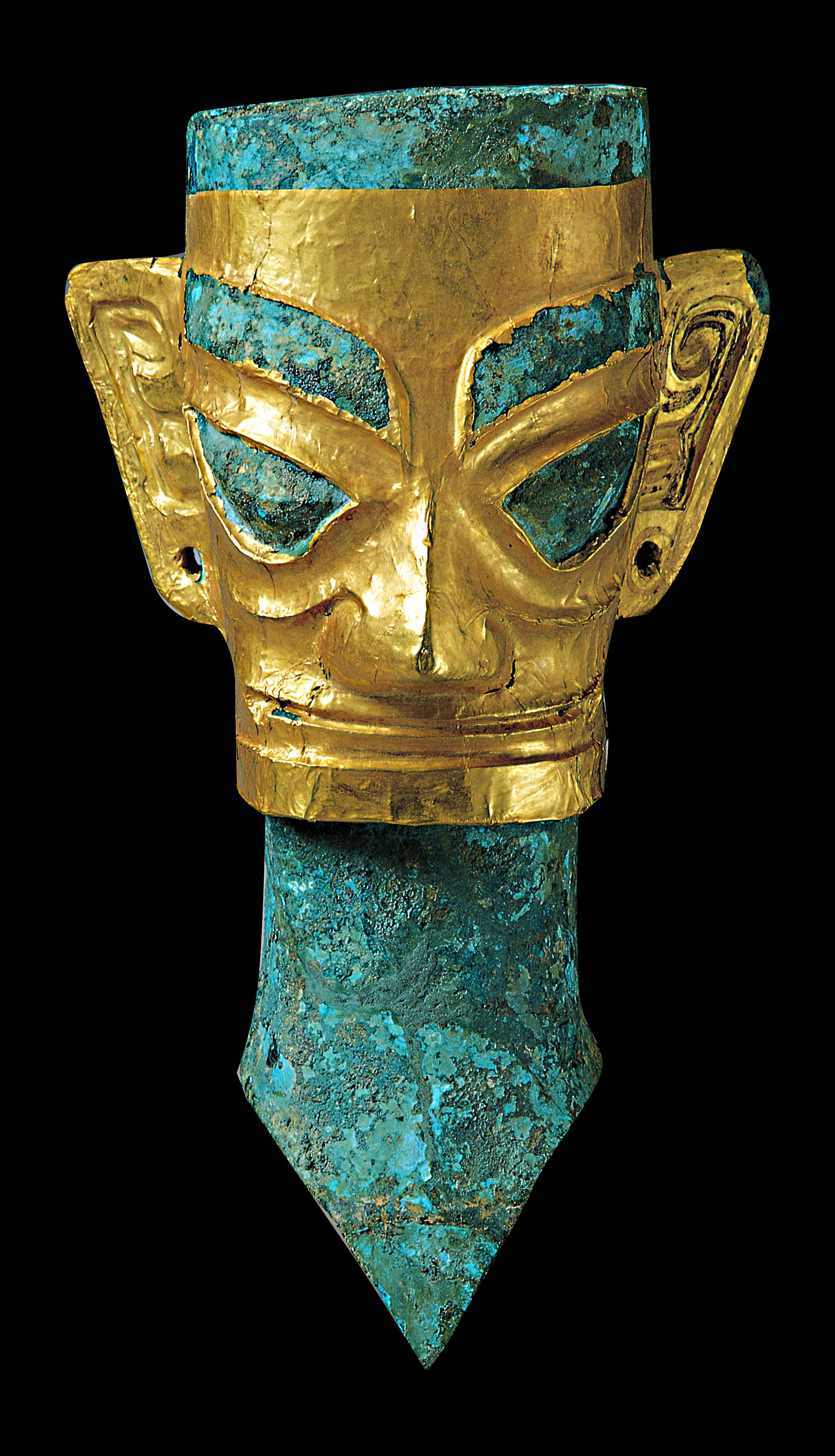
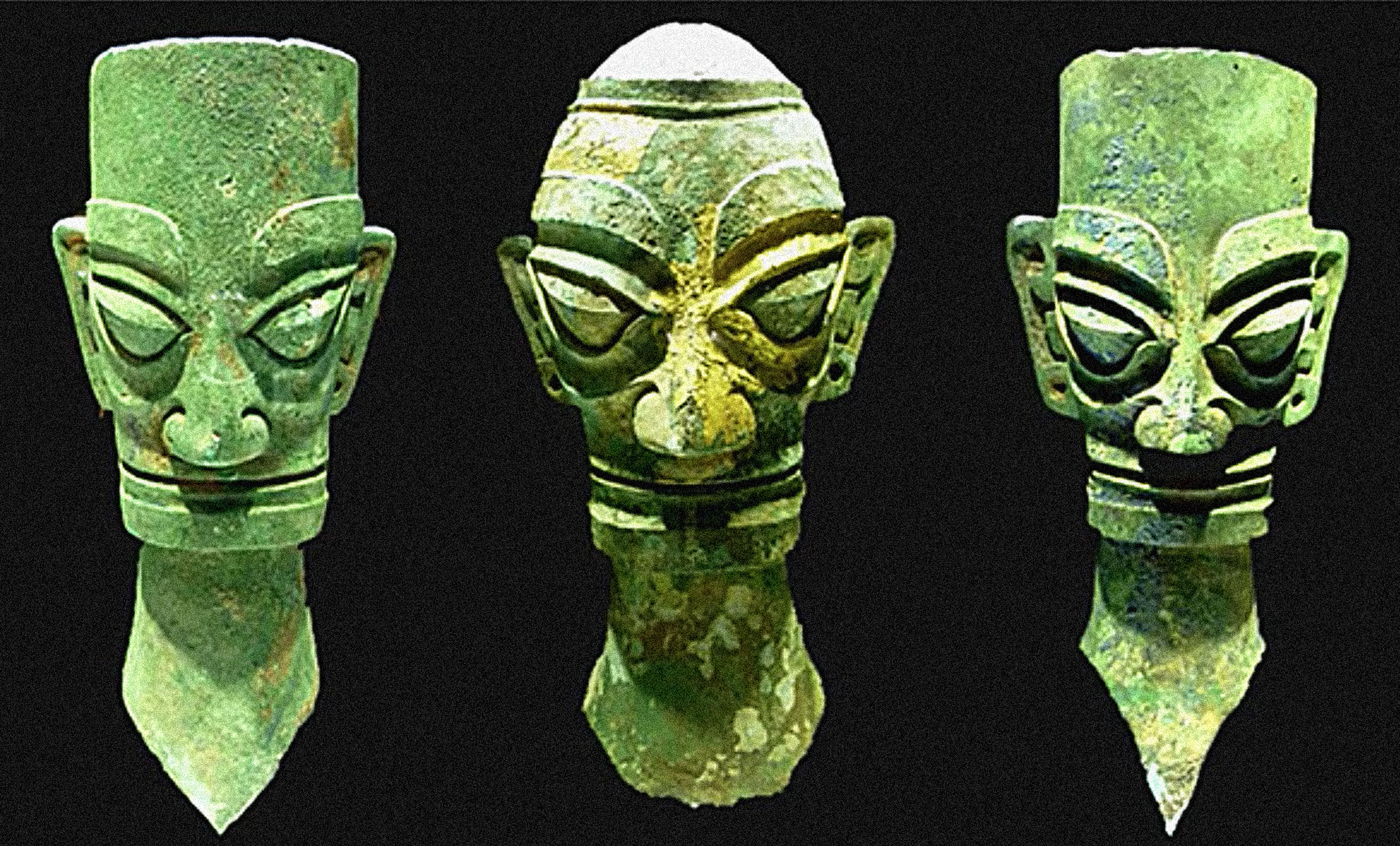
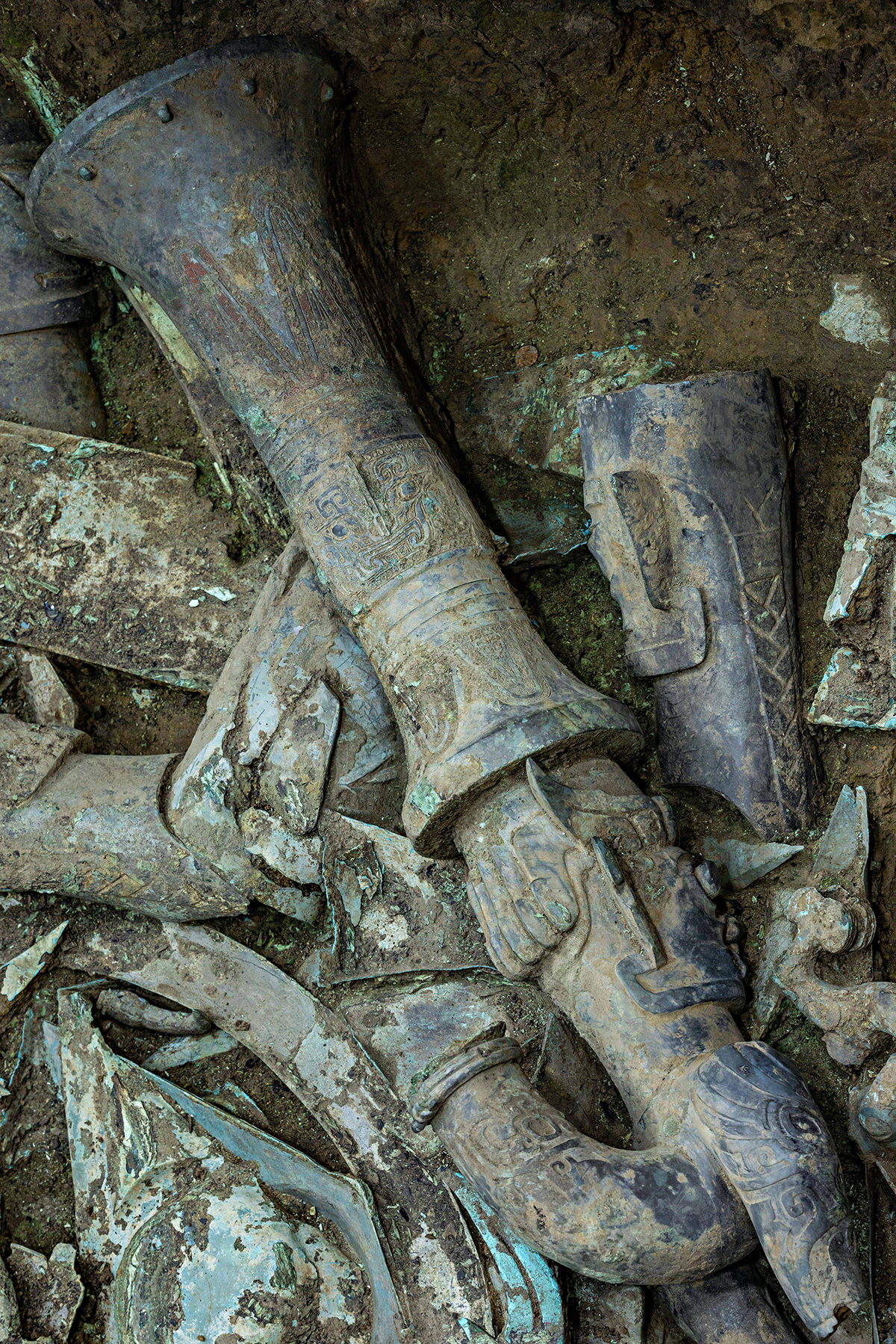
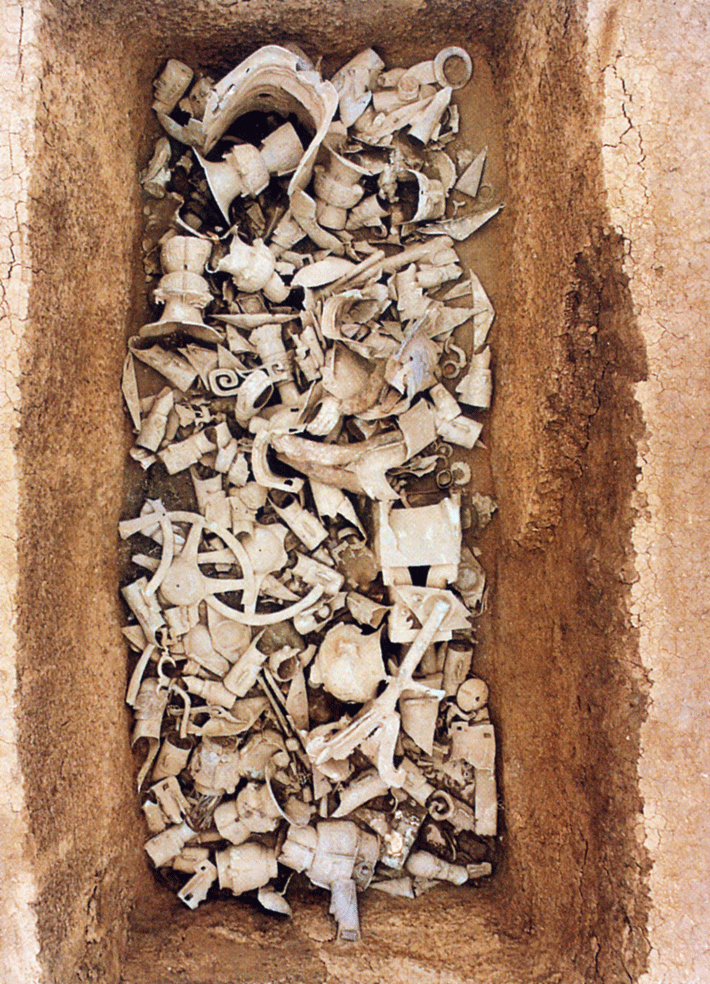
︎ Sacrificial pits containing relics and elephant tusks.

Originally discovered in the late 1920s by a local farmer, artefacts from the Sanxingdui (a culture dating from the middle Bronze Age, 3000BC), were dubbed as one of the world's greatest archaeological finds of the 20th century. However, they were only recognised as significant discoveries in the late 1980s when thousands more artefacts were accidentally unearthed from two sacrificial pits by construction workers.
The pits contained thousands of gold, bronze, jade, and pottery artefacts that had been intentionally broken, burned, and carefully buried. In total, six pits have been excavated to date, where around 1,000 elephant tusks (perhaps as a shamanic icon referencing a subspecies of Asian elephant) and thousands more cowrie shells have been found, which had the unintended effect of buffering the soil's acidity and helping to preserve the contents.
In addition, the discovery of house remains and a city wall show that agriculture, animal husbandry, handicrafts and architecture had developed by that time, creating the foundations for a civilised society that could undertake projects of this nature and size. Furthermore, the inclusion of cowrie shells, which originate from the Indian Ocean, suggest an interconnected trading network that would discredit aspects of the notion that civilisation arose from a single centre of urban influence further east in the Central Planes.
Some of the most outstanding examples of artistry and technical ability have been characterised by the Sanxingdui, most particularly the Tree of Life (thought to represent the later Fusang mythological tree) and the life-size bronze figure of a ceremonial shaman that stands barefoot on an elephant mounted podium, at 2.62m tall.
The pits contained thousands of gold, bronze, jade, and pottery artefacts that had been intentionally broken, burned, and carefully buried. In total, six pits have been excavated to date, where around 1,000 elephant tusks (perhaps as a shamanic icon referencing a subspecies of Asian elephant) and thousands more cowrie shells have been found, which had the unintended effect of buffering the soil's acidity and helping to preserve the contents.
In addition, the discovery of house remains and a city wall show that agriculture, animal husbandry, handicrafts and architecture had developed by that time, creating the foundations for a civilised society that could undertake projects of this nature and size. Furthermore, the inclusion of cowrie shells, which originate from the Indian Ocean, suggest an interconnected trading network that would discredit aspects of the notion that civilisation arose from a single centre of urban influence further east in the Central Planes.
Some of the most outstanding examples of artistry and technical ability have been characterised by the Sanxingdui, most particularly the Tree of Life (thought to represent the later Fusang mythological tree) and the life-size bronze figure of a ceremonial shaman that stands barefoot on an elephant mounted podium, at 2.62m tall.
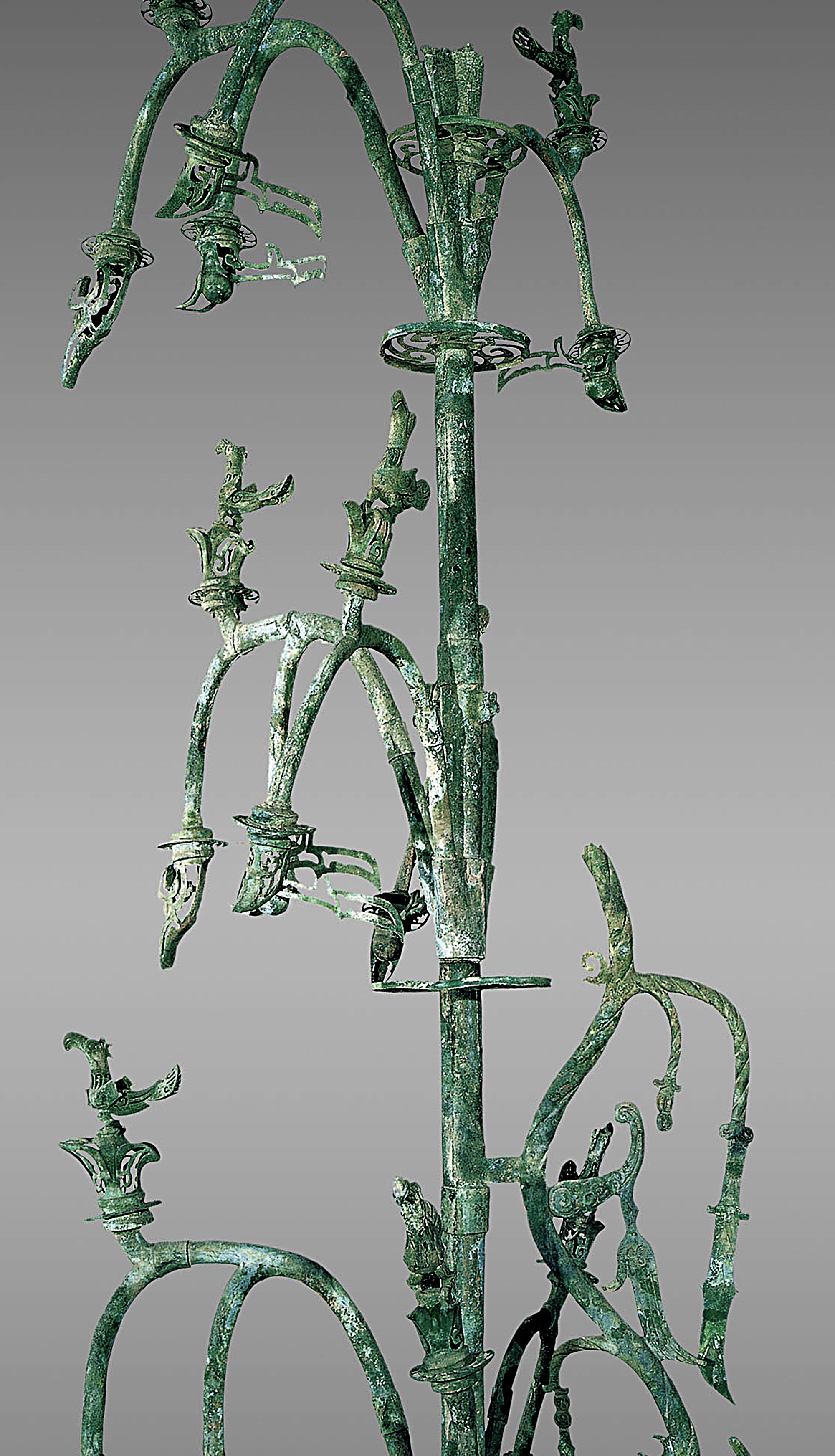
︎ Bronze Tree of Life, Spirit Tree, Axis Mundi (3.95m tall).

︎ The Bronze Figure, 1600BC (2.62m tall).
The Sanxingdui (meaning ‘Three Star Mound’) were a Bronze Age civilisation that flourished in China’s fertile Sichuan Basin for several hundred years before mysteriously disappearing around 1200 B.C. They flourished in a time when it was thought that the cradle of Chinese civilisation lay to the northeast, on the Yellow River, in China’s Central Plain region. However, the existence of the Sanxingdui culture completely defies this traditional theory of Chinese history.
The archaeological discoveries make evident that the state backed Xia–Shang–Zhou Chronology Project cannot equate Chinese history to a sequential narrative of a procession of single ruling states, as suggested by the traditional historiographic sources. Rather that the Shang cultural narrative (considered the source of the earliest written Chinese characters) simply establishes a change in the form of time - from mythological to historical - by way of two individuals known as Xie (偰) and Yu the Great (禹), mythical twins who helped redirect the waters caused by ‘the great flood’.
Early bronze-age China, rather than having a single, centralised origin, was instead inhabited by numerous communities with different cultural traditions, several of which proved to be politically and technoloigcally superior to the Shang and Zhou dynasties, and were able to dominate a larger territory for a certain time (source).
This is what makes the Sanxingdui cultural artefacts (situated in the outer western regions of China) so intruiging and mysterious within the narrative of China’s early cultural formation.
Their bronze scupltures are more technically advanced than other areas of China for this time, even though the culture is older (dating back some 5,000 years, roughly one thousand years older than the first dynasty). Additionally, the style and symbology of the Sanxingdui are idiosyncratic and completely unknown within early, traditional Chinese symbology and production methods.
The archaeological discoveries make evident that the state backed Xia–Shang–Zhou Chronology Project cannot equate Chinese history to a sequential narrative of a procession of single ruling states, as suggested by the traditional historiographic sources. Rather that the Shang cultural narrative (considered the source of the earliest written Chinese characters) simply establishes a change in the form of time - from mythological to historical - by way of two individuals known as Xie (偰) and Yu the Great (禹), mythical twins who helped redirect the waters caused by ‘the great flood’.
Early bronze-age China, rather than having a single, centralised origin, was instead inhabited by numerous communities with different cultural traditions, several of which proved to be politically and technoloigcally superior to the Shang and Zhou dynasties, and were able to dominate a larger territory for a certain time (source).
This is what makes the Sanxingdui cultural artefacts (situated in the outer western regions of China) so intruiging and mysterious within the narrative of China’s early cultural formation.
Their bronze scupltures are more technically advanced than other areas of China for this time, even though the culture is older (dating back some 5,000 years, roughly one thousand years older than the first dynasty). Additionally, the style and symbology of the Sanxingdui are idiosyncratic and completely unknown within early, traditional Chinese symbology and production methods.
For example, according to Huo Wei, the dean of the School of Archaeology, Culture and Museum at Sichuan University, the 112 bronze wares that were excavated from the two sacrificial pits in 1986 showed that people living in the ancient kingdom of Shu (of which Sanxingdui was a continuation) had another hierarchy and worshiping system which can be seen in their relics including gold masks, bronze standing figures and the bronze tree that are totally different with those from the Central Plains.
The historical position and cultural relationship between the Central Plains and the western regions of the Sanxingdui are still far from resolved.
The Sanxingdui are also said to have been contemporaneous with the Bashu culture in Jinsha (another region of Sichuan), where they are thought to have migrated towards their eventual decline. Collectively these two regions were part of the Shu Kingdom, which was largely a mixture of mythological stories and historical legends found in local annals, which rendered this era of Chinese history in a similar light to the ancient Greek account of the once mythical city of Troy, which was later discovered to be an actual city by Heinrich Schliemann.
One particular artefact that ties into the mythological narrative of the Shu kingdom is contained in the artistic detailing of a golden sceptre that was found in the excavations from the 1980s.
Dating back around 4,000 to 3,600 years, the gold sceptre was the largest of its kind to be unearthed in China at that time, and is particularly intruiging as the sceptre/staff symbology is not something particular to China but more common in ancient Sumerian, Egyptian and Indian cultures. As a sign or insignia of royal divinity, the Ding (鼎) cooking vessel was more commonly used in later Chinese symbology.
Described as one of the national treasures with the greatest historical and scientific significance, the gold sceptre is believed to symbolise this same kind of royal divinity as a record of ages.
The historical position and cultural relationship between the Central Plains and the western regions of the Sanxingdui are still far from resolved.
The Sanxingdui are also said to have been contemporaneous with the Bashu culture in Jinsha (another region of Sichuan), where they are thought to have migrated towards their eventual decline. Collectively these two regions were part of the Shu Kingdom, which was largely a mixture of mythological stories and historical legends found in local annals, which rendered this era of Chinese history in a similar light to the ancient Greek account of the once mythical city of Troy, which was later discovered to be an actual city by Heinrich Schliemann.
One particular artefact that ties into the mythological narrative of the Shu kingdom is contained in the artistic detailing of a golden sceptre that was found in the excavations from the 1980s.
Dating back around 4,000 to 3,600 years, the gold sceptre was the largest of its kind to be unearthed in China at that time, and is particularly intruiging as the sceptre/staff symbology is not something particular to China but more common in ancient Sumerian, Egyptian and Indian cultures. As a sign or insignia of royal divinity, the Ding (鼎) cooking vessel was more commonly used in later Chinese symbology.
Described as one of the national treasures with the greatest historical and scientific significance, the gold sceptre is believed to symbolise this same kind of royal divinity as a record of ages.
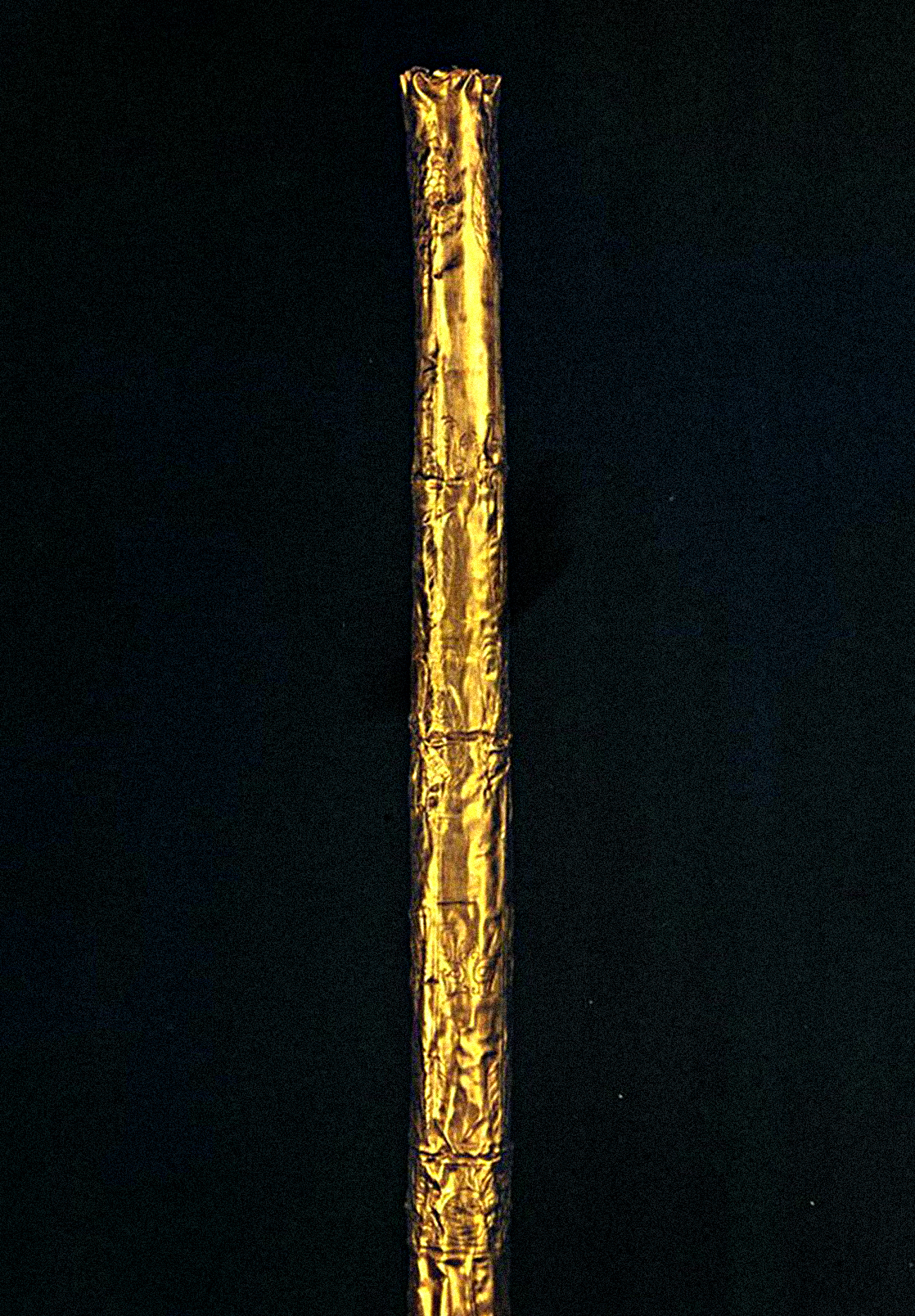
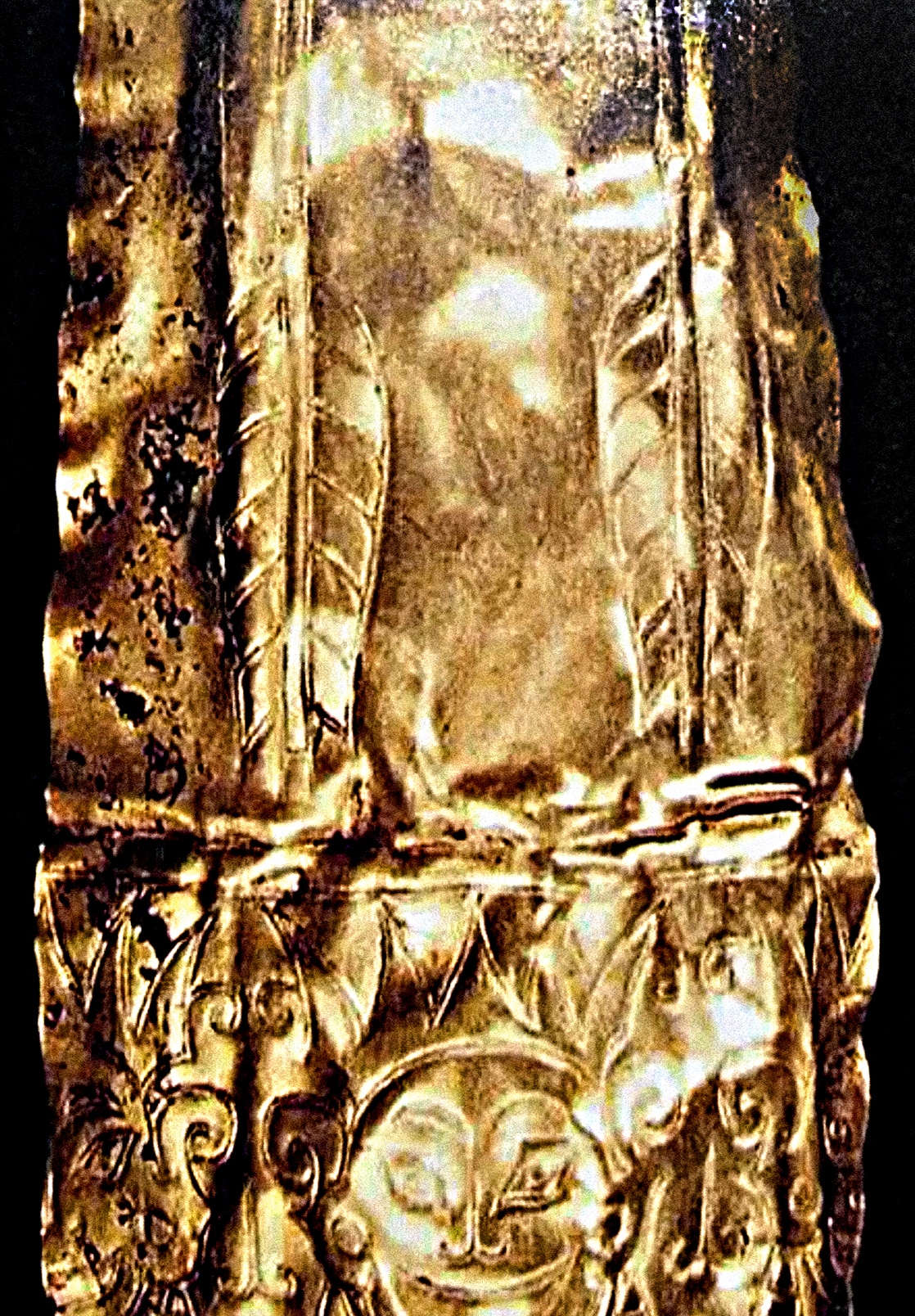
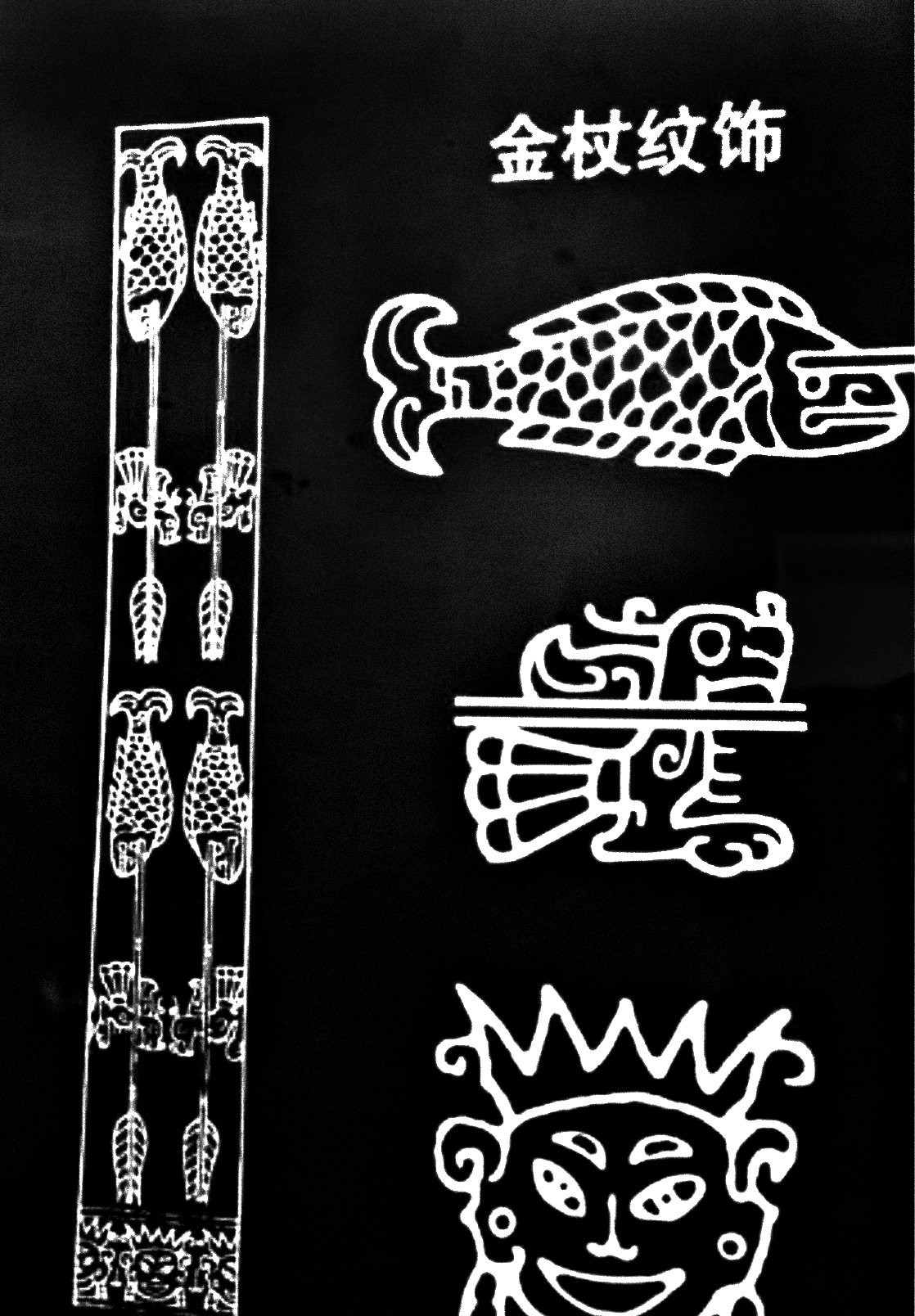
︎ Golden Sceptre details.

The golden sceptre also reflects the exquisitely detailed gold leaf designs and smelting techniques of the time, as the gold had to be hammered thin enough to cover the limited surface of the wooden stick around which it is wrapped.
Upon closer examination, the staff displays patterns of human heads, fish, birds, and arrows that some researchers say reflect the ancestral worship of the ancient Shu people, which coincides with the mythical accounts of the five Shu culture heroes; Can Cong, Baiguan, Yufu, Du Yu, and Kaiming.
Since the Shu people were not a single homogeneous people, but instead consisting of multiple heterogeneous groups from near and far, they are similar in structure to the likes of the Celts and Jōmon.
Their clan lineages are indeterminate with a reliance upon mythical accounts of cultural figures such as those mentioned above.
Arguably the most notable of these culture heroes is Can Cong, who’s totem "Silkworm” was ascribed to him due to his blue/green clothing and his knowledge of silkworm cultivation he was said to have spread throughout the kingdom. According to legend from later cultures (as the Sanxingdui have no written records), Can Cong is described as being immortal and having ‘vertical eyes’ (muzong - 目纵) which are most likely depicted in the shamanic rendering of the largest of the Sanxingdui bronze masks.
The strange symbology of the pertruding eyes are yet to be deciphered, but some have suggested that later Chinese traditions (attributed to Wei Xie and Zhang Sengyou), that artists would sometimes refrain from painting the eyes of deities and supernatural forces such as dragons. When Zhang Sengyou was urged to paint the eyes of a dragon, as one story recounts, the walls immediately collapsed and the dragon flew into the sky.
The suggestion is that these bronze masks record the supernatural power of vision that can extend through various dimensions. In addition to the ‘nose motif’, this could also suggest a connection to a heavenly realm through the animating principle of lightning (often linked to new technological processes) - interestingly not too dissimilar from the Mayan depiction of rain god Chaac.
Upon closer examination, the staff displays patterns of human heads, fish, birds, and arrows that some researchers say reflect the ancestral worship of the ancient Shu people, which coincides with the mythical accounts of the five Shu culture heroes; Can Cong, Baiguan, Yufu, Du Yu, and Kaiming.
Since the Shu people were not a single homogeneous people, but instead consisting of multiple heterogeneous groups from near and far, they are similar in structure to the likes of the Celts and Jōmon.
Their clan lineages are indeterminate with a reliance upon mythical accounts of cultural figures such as those mentioned above.
Arguably the most notable of these culture heroes is Can Cong, who’s totem "Silkworm” was ascribed to him due to his blue/green clothing and his knowledge of silkworm cultivation he was said to have spread throughout the kingdom. According to legend from later cultures (as the Sanxingdui have no written records), Can Cong is described as being immortal and having ‘vertical eyes’ (muzong - 目纵) which are most likely depicted in the shamanic rendering of the largest of the Sanxingdui bronze masks.
The strange symbology of the pertruding eyes are yet to be deciphered, but some have suggested that later Chinese traditions (attributed to Wei Xie and Zhang Sengyou), that artists would sometimes refrain from painting the eyes of deities and supernatural forces such as dragons. When Zhang Sengyou was urged to paint the eyes of a dragon, as one story recounts, the walls immediately collapsed and the dragon flew into the sky.
The suggestion is that these bronze masks record the supernatural power of vision that can extend through various dimensions. In addition to the ‘nose motif’, this could also suggest a connection to a heavenly realm through the animating principle of lightning (often linked to new technological processes) - interestingly not too dissimilar from the Mayan depiction of rain god Chaac.
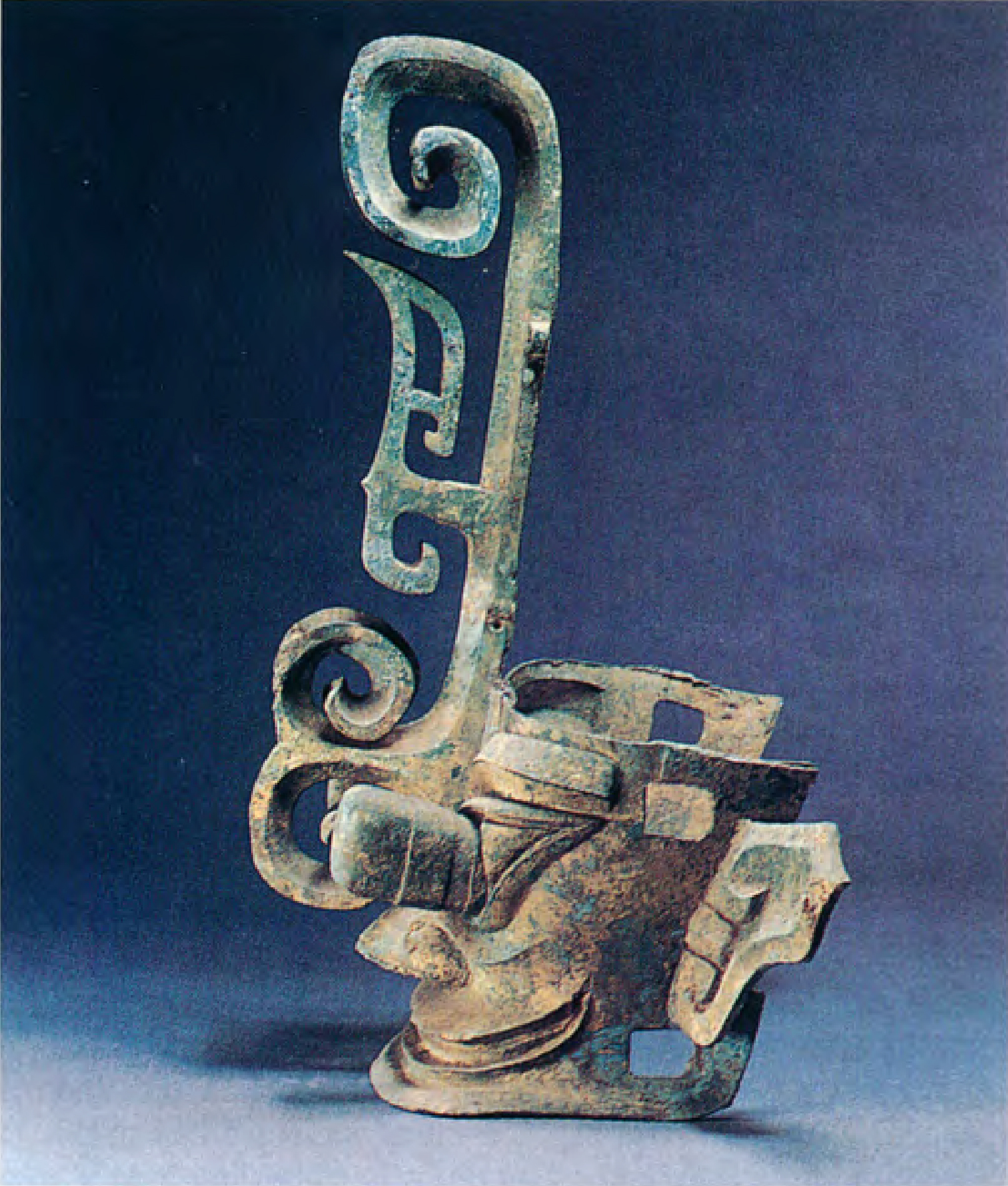

︎ Mask from Pit 2 (82cm tall).


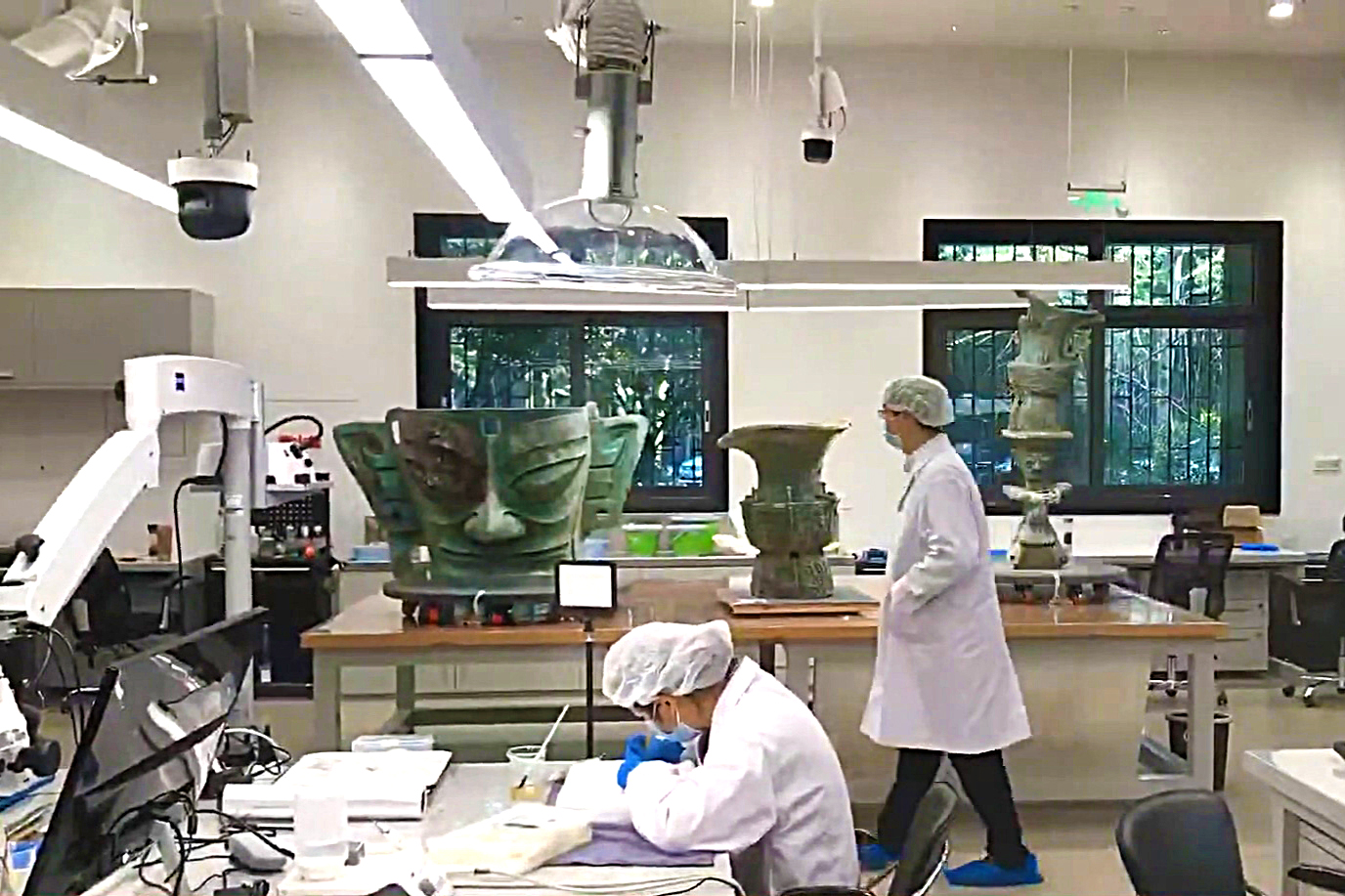
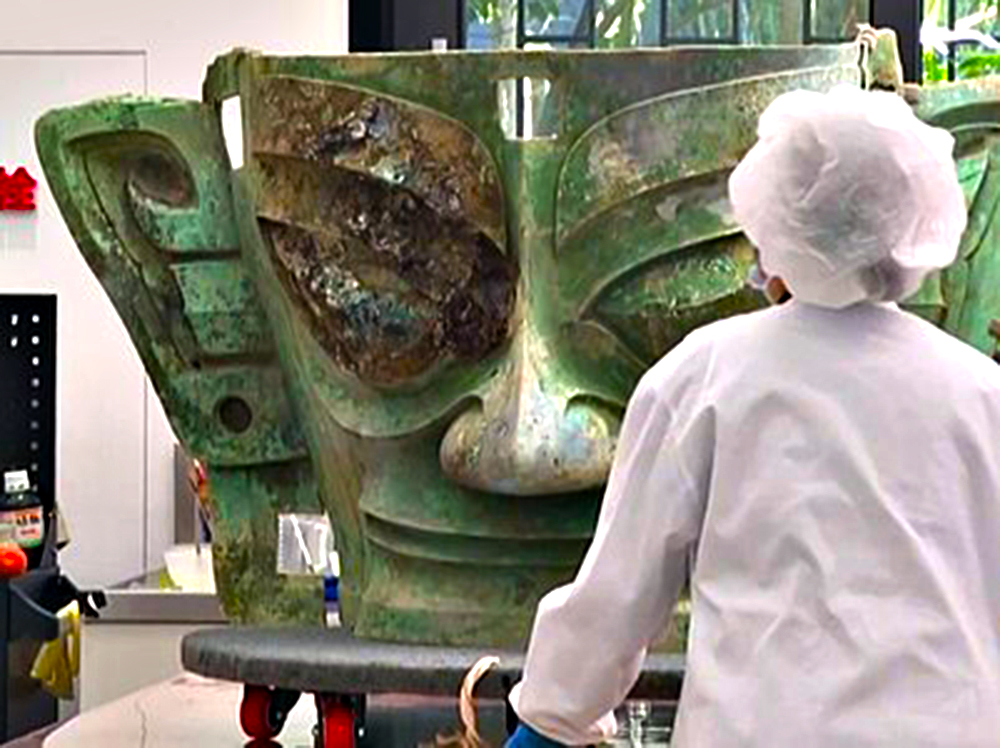
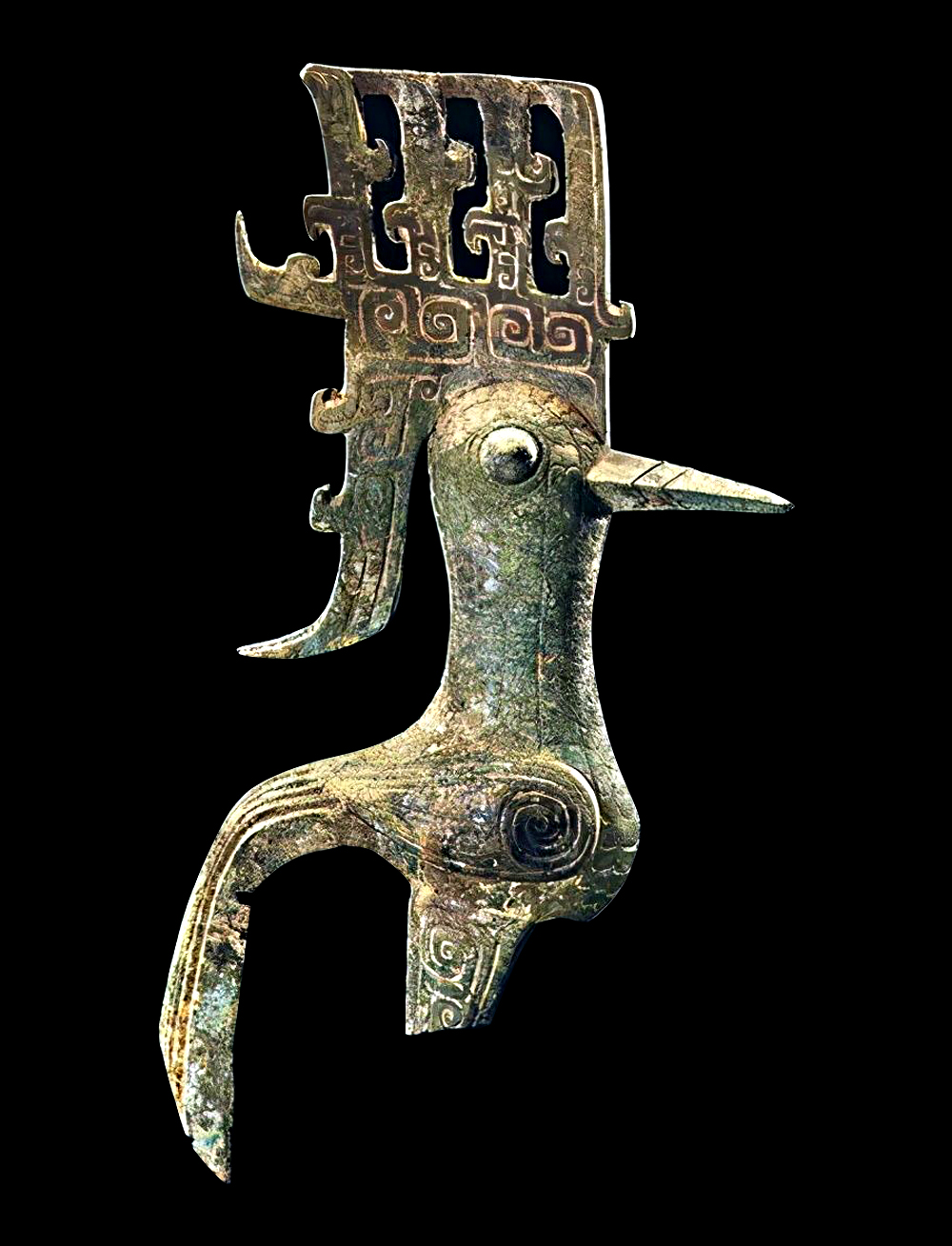
The remaining mythical dynasties of the Shu kingdom all share corresponding totemic features to the natural world that can be briefly summarised as Baiguan ("White Crane"), Yufu ("Fish / Cormorant"), Du Yu ("Cookoo") and Kaiming ("Turtle / Sun"), all of which represent phases of development and decline due to climate changes brought about by earthquakes and changes in political structure as the Bronze Age tribal cultures slowly migrated and were absorbed into more sedentary and uniform ways of living.
What seems to be a common feature that bound tribal confederacies of this mythical era together was their veneration for totemic animals and the kinds of magical attributes they inspired in the construction of an identity. Human-animal hybrids are not uncommon and speak to the supernatural and liminal realms that often typify changes in consciousness and poetic affiliation with new technologies and modes of expression - even writing.
Although evidence of writing has not yet been proven within the Sanxingdui culture, it is possible to think that the conceptual seeds of what became the Oracle Bone Script of the later Shang Dynasty were developed in these early Bronze Age cultures, which is further supported by the Jaihu symbols, which date to an even earlier time of 6000BC.
There is also an uncanny visual resonance between some of the totemic animals that were used by the Sanxingdui (such as birds, dragons and serpents) and later characters from the Oracle Bone script.
The idea that written language itself is a fossilied poem and contains the natural phenomena that had to be witnessed in the process of its creation, is something that can be ascribed to morphemic systems like modern Chinese for example (where the basic unit of a word is still visually represented in the meaning it portrays). The visual vernacular of the eye itself, so exaggerated in the Shu kingdom culture, is also ascribed to its later Oracle Bone character, which consists of an eye with a serpentine body (source).
![]()
What seems to be a common feature that bound tribal confederacies of this mythical era together was their veneration for totemic animals and the kinds of magical attributes they inspired in the construction of an identity. Human-animal hybrids are not uncommon and speak to the supernatural and liminal realms that often typify changes in consciousness and poetic affiliation with new technologies and modes of expression - even writing.
Although evidence of writing has not yet been proven within the Sanxingdui culture, it is possible to think that the conceptual seeds of what became the Oracle Bone Script of the later Shang Dynasty were developed in these early Bronze Age cultures, which is further supported by the Jaihu symbols, which date to an even earlier time of 6000BC.
There is also an uncanny visual resonance between some of the totemic animals that were used by the Sanxingdui (such as birds, dragons and serpents) and later characters from the Oracle Bone script.
The idea that written language itself is a fossilied poem and contains the natural phenomena that had to be witnessed in the process of its creation, is something that can be ascribed to morphemic systems like modern Chinese for example (where the basic unit of a word is still visually represented in the meaning it portrays). The visual vernacular of the eye itself, so exaggerated in the Shu kingdom culture, is also ascribed to its later Oracle Bone character, which consists of an eye with a serpentine body (source).

︎ Bird, Tree and Shu Kingdom character (serpentine eye).

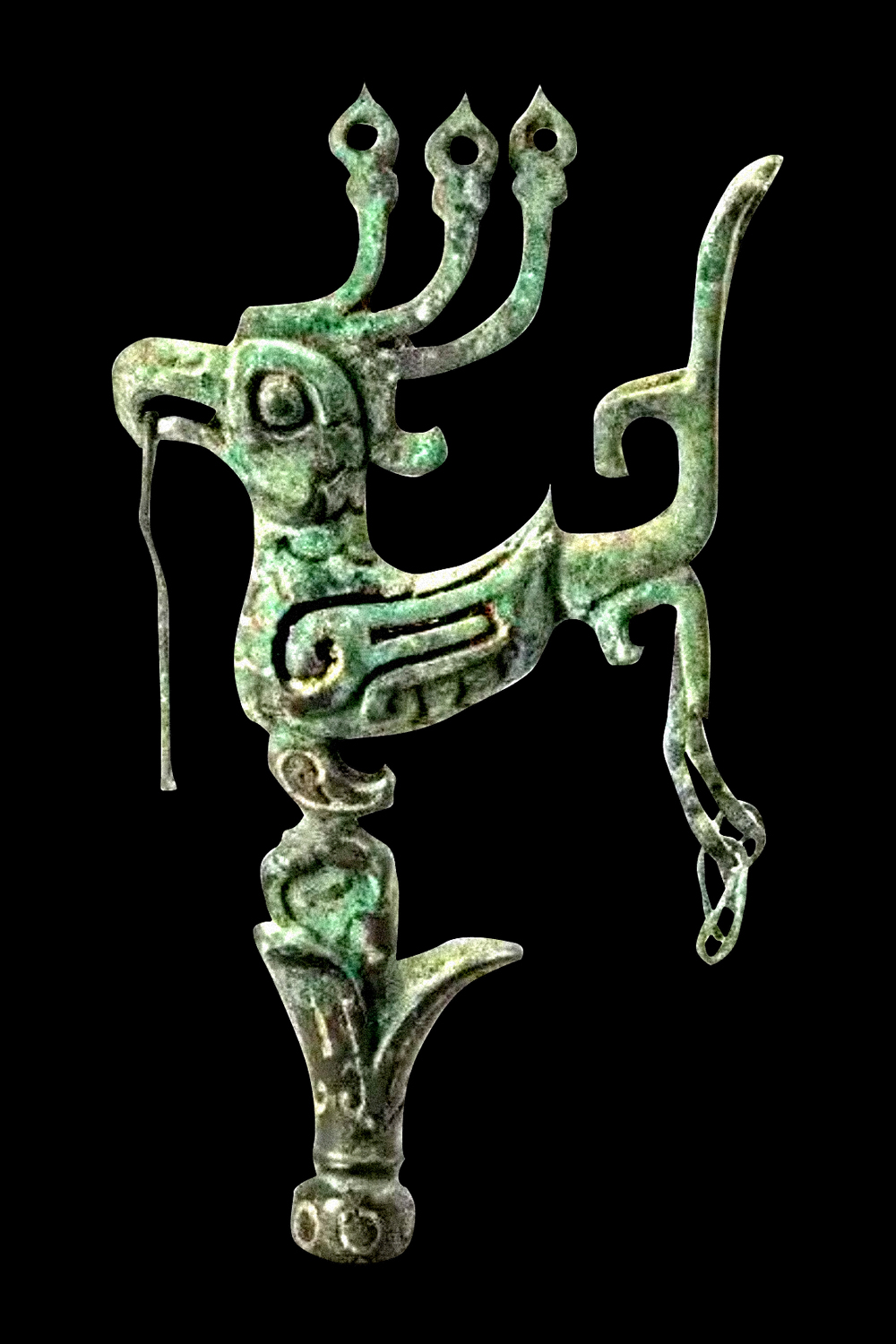
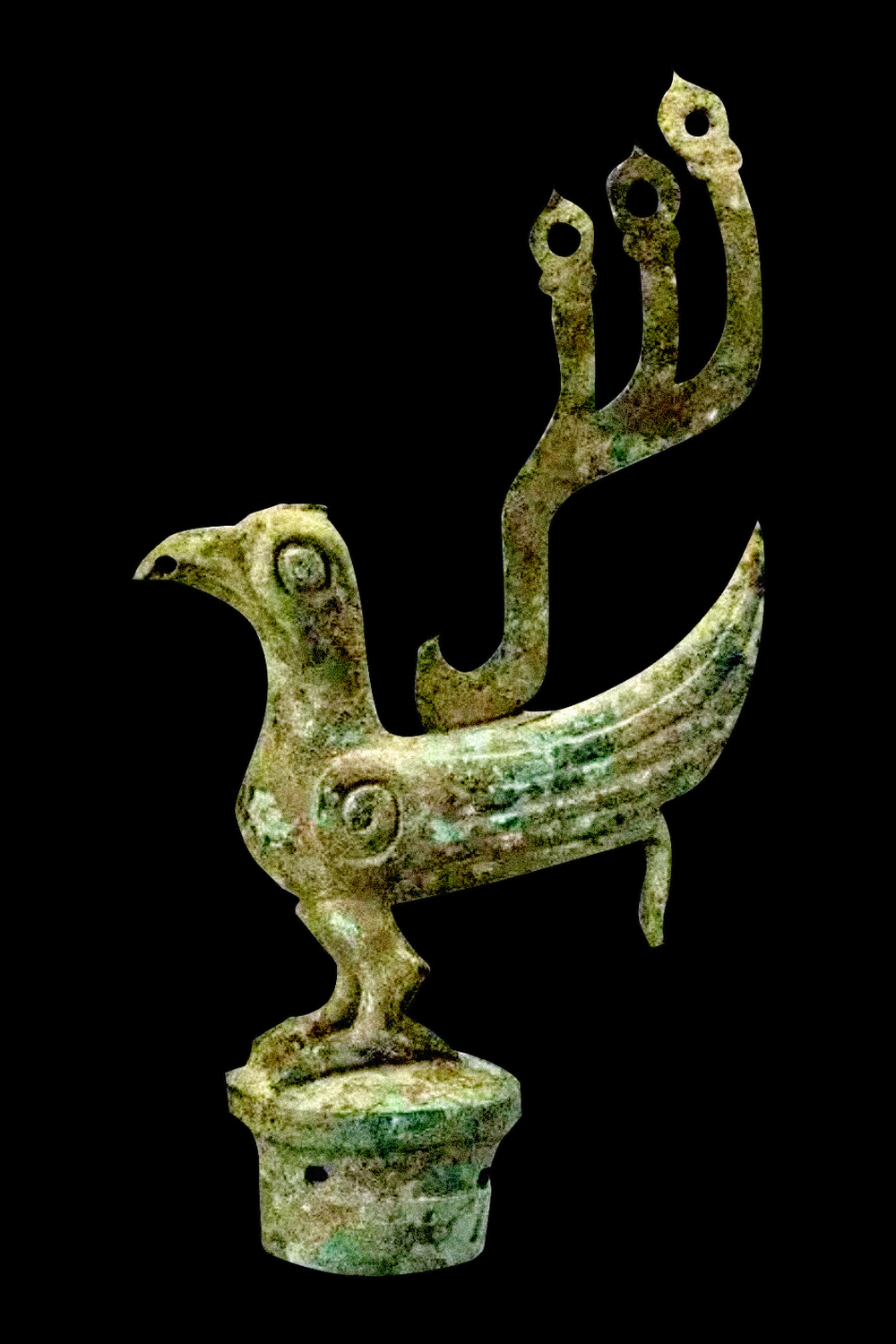
The archetypal symbols that seem to transform humanity’s spiritual vision are often mediated through establishing magical relationships with the energies that swirl within the ever-changing environments we find ourselves in. Although their appearance can give the impression of idiosyncrasies held within small tribal groups, their apparent transcendence between space, time and cultural development suggests the existence of a kind of chaos theory of cross-cultural cosmology, a spontaneous order or morphic resonance that weaves a common thread through seemingly disparate cultural expressions. Or on the other hand, as Graeber stated, identity can be a form of ‘culture as creative refusal’ by way of actively not adopting a certain technology that appears more prominently in another neighbouring culture - such as writing. The Sanxingdui are a direct example of this in that their symbology is thought to fall outside of the traditional Chinese aesthetic, which gives them their mysterious lustre.
In the historical narrative, their regions were until recently thought of as being desolate and devoid of complexity. In the same way the ancient Greeks and Romans used the term ‘barbarian’ to distinguish themselves from those groups who were deemed less civilised, these regions were thought of as the "Lands beyond moral influence” during the Shang dynasty.
In the historical narrative, their regions were until recently thought of as being desolate and devoid of complexity. In the same way the ancient Greeks and Romans used the term ‘barbarian’ to distinguish themselves from those groups who were deemed less civilised, these regions were thought of as the "Lands beyond moral influence” during the Shang dynasty.
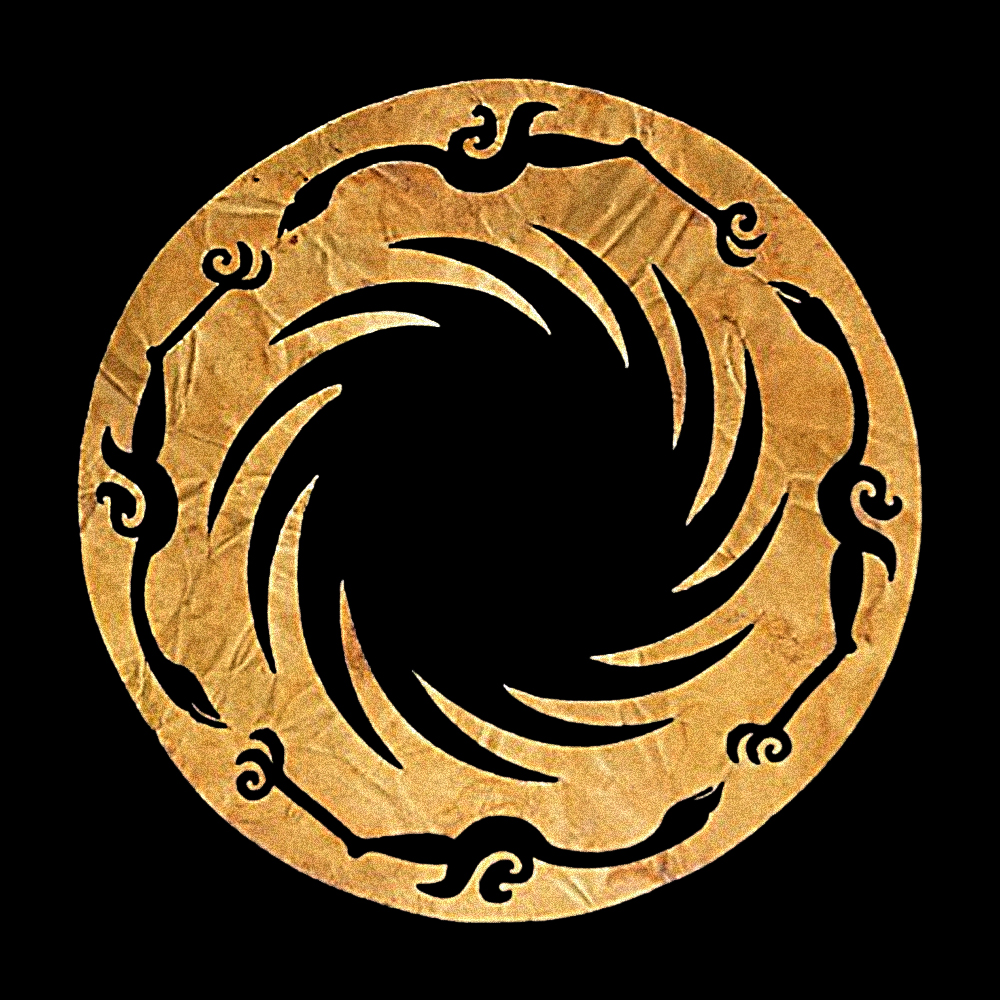
︎ Golden Sun Bird Disc (found at the Jinsha ruins).
If, as Karl Jaspers put forward in his understanding of the ‘axial age’, that all modern thought now perceives the world through ideas inherited around 500BC, then a common underlying element which might unite these emerging traditions is a ‘straining towards transcendence’ or a strange movement that passed through the spirit of all ‘civilised’ people at that time (source), then, we must also remember the ‘uncivilised’, the nomadic, the barbarian regions of the magical hinterlands of mythic history that comprised most of Eurasia and the rest of the world, and provided the ingredients for this axial shift to take place during a phase before axial culture heroes became restricted to their national identities.
It should be taken into respectful consideration that Lao Tzu or Gautama Buddha’s world view, for example, didn’t just emerge without any historical development to become a cultural legacy of Asia. These ideas circulated and were exchanged between people as far ranging as the British Isles to the Pontic Steppe, long before the Silk Routes were established and for some one thousand five hundred years before the likes of Daoism or Buddhism (as we understand them today) reached southeast Asia.The expanse and complexity of the Sanxingdui artefacts are much more far reaching than first imagined and have prompted some researchers to look at the later Iron Age Andronovo and Pazyryk cultures of the Altai Mountains as possible influence. Although being later cultures, a deeper connection in prehistory could be possible as some of their well-preserved tapestries share resemblance to Sanxingdui art and symbology.
It should be taken into respectful consideration that Lao Tzu or Gautama Buddha’s world view, for example, didn’t just emerge without any historical development to become a cultural legacy of Asia. These ideas circulated and were exchanged between people as far ranging as the British Isles to the Pontic Steppe, long before the Silk Routes were established and for some one thousand five hundred years before the likes of Daoism or Buddhism (as we understand them today) reached southeast Asia.The expanse and complexity of the Sanxingdui artefacts are much more far reaching than first imagined and have prompted some researchers to look at the later Iron Age Andronovo and Pazyryk cultures of the Altai Mountains as possible influence. Although being later cultures, a deeper connection in prehistory could be possible as some of their well-preserved tapestries share resemblance to Sanxingdui art and symbology.
There are many aspects of history and dimensions of ancient thought that are yet to be fully explored and incorporated into a more cohesive image of how mythical narratives have influenced the course of historical culture on a local and global scale. As more advanced, lost civilisations come to the surface, they will continue to challenge the idea that cradles of civilisation neatly fit into institutionalised ideas of national identity and perhaps encourage broader perspectives when dealing with the value that cultural exchange has upon the spiritual and creative enhancement of humanity as a whole.
“The wise people act without effort and teach by quiet example. They accept things as they come, create without possessing, nourish without demanding, and accomplish without taking credit. Because they constantly forget themselves, they are never forgotten.” - Lao Tzu.


Further Reading ︎
Shine News, article
China Daily, article
Exotic Jades, article
The Histoy Blog, archive, article
All About the Eyes, Wu Hung, pdf
Ancient Chinese Metallurgy, video
Seismic Shift, Archaeology Magazine, article
Culture as Creative Refusal, David Graeber, essay
The Ancients: Axial Age, Wes Cecil PhD, lecture
Karl Jaspers and the actuality of the axial age, article
Shine News, article
China Daily, article
Exotic Jades, article
The Histoy Blog, archive, article
All About the Eyes, Wu Hung, pdf
Ancient Chinese Metallurgy, video
Seismic Shift, Archaeology Magazine, article
Culture as Creative Refusal, David Graeber, essay
The Ancients: Axial Age, Wes Cecil PhD, lecture
Karl Jaspers and the actuality of the axial age, article